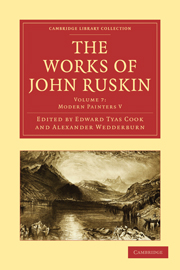Book contents
- Frontmatter
- Contents
- LIST OF ILLUSTRATIONS
- INTRODUCTION TO THIS VOLUME
- BIBLIOGRAPHICAL NOTE
- Modern Painters, Vol. V.
- PREFACE
- PART VI “OF LEAF BEAUTY”
- PART VII “OF CLOUD BEAUTY”
- PART VIII “OF IDEAS OF RELATION:—FIRST, OF INVENTION FORMAL”
- CHAP. I THE LAW OF HELP
- CHAP. II THE TASK OF THE LEAST
- CHAP. III THE RULE OF THE GREATEST
- CHAP. IV THE LAW OF PERFECTNESS
- PART IX “OF IDEAS OF RELATION:—SECOND, OF INVENTION SPIRITUAL”
- EPILOGUE (1888)
- APPENDIX
- Plate section
CHAP. II - THE TASK OF THE LEAST
Published online by Cambridge University Press: 07 September 2011
- Frontmatter
- Contents
- LIST OF ILLUSTRATIONS
- INTRODUCTION TO THIS VOLUME
- BIBLIOGRAPHICAL NOTE
- Modern Painters, Vol. V.
- PREFACE
- PART VI “OF LEAF BEAUTY”
- PART VII “OF CLOUD BEAUTY”
- PART VIII “OF IDEAS OF RELATION:—FIRST, OF INVENTION FORMAL”
- CHAP. I THE LAW OF HELP
- CHAP. II THE TASK OF THE LEAST
- CHAP. III THE RULE OF THE GREATEST
- CHAP. IV THE LAW OF PERFECTNESS
- PART IX “OF IDEAS OF RELATION:—SECOND, OF INVENTION SPIRITUAL”
- EPILOGUE (1888)
- APPENDIX
- Plate section
Summary
§ 1. The reader has probably been surprised at my assertions made often before now, and reiterated here, that the minutest portion of a great composition is helpful to the whole. It certainly does not seem easily conceivable that this should be so. I will go farther, and say that it is inconceivable. But it is the fact.
We shall discern it to be so by taking one or two compositions to pieces, and examining the fragments. In doing which, we must remember that a great composition always has a leading emotional purpose, technically called its motive, to which all its lines and forms have some relation. Undulating lines, for instance, are expressive of action; and would be false in effect if the motive of the picture was one of repose. Horizontal and angular lines are expressive of rest and strength; and would destroy a design whose purpose was to express disquiet and feebleness. It is therefore necessary to ascertain the motive before descending to the detail.
§ 2. One of the simplest subjects, in the series of the Rivers of France, is “Rietz, near Saumur.” The published Plate gives a better rendering than usual of its tone of light; and my rough etching, Plate 73, sufficiently shows the arrangement of its lines. What is their motive?
To get at it completely, we must know something of the Loire.
- Type
- Chapter
- Information
- The Works of John Ruskin , pp. 217 - 229Publisher: Cambridge University PressPrint publication year: 2010First published in: 1903



